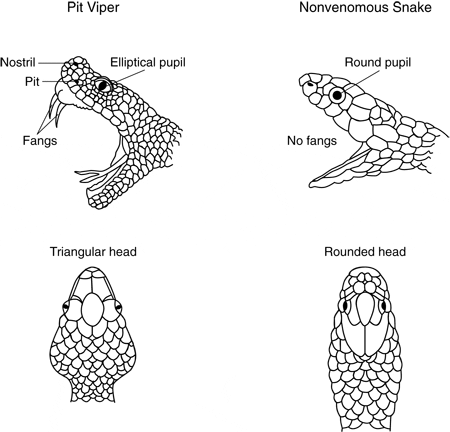
How to distinguish a viper from a snake: the main distinguishing features
Each season has its positive and, unfortunately, negative sides. The onset of the summer season brings with it vivid emotions from the hot sun, rich harvest and fresh air, adjacent to fears of getting bitten by any insect or even a snake. Snakes live almost everywhere, so if you are a summer resident, a resident of a country house, or just a caring parent, you will probably be interested in the question “how to distinguish a viper from a snake.”
Why these particular snakes? The viper and snake are the most common snakes in our forest belt, and if the snakes are completely safe for humans, a meeting with a viper can turn into trouble, but we all know that snakes should not be killed.
Differences between a snake and a viper
Before you go to the forest for berries or mushrooms, go on a picnic with your child outside the city, just relax or work in the garden, you should be aware that in these places you can meet a snake. So that such a meeting does not bring trouble, you need to know how it differs from a viper, how to behave when meeting a snake and how to provide first aid if a snake bite does occur.
Main differences
As noted, already, unlike the viper, it is not dangerous to humans. Viper is poisonous legless reptile, its number is quite large in our country. To distinguish a viper from a snake, we list the main distinguishing features of both reptiles. Let’s start with already:
- the average length of adult snakes is 100 cm, although there are snakes longer than a meter;
- snakes have two spots closer to the head of a yellow or orange hue;
- have a bright color of black, brown or gray shades;
- in addition to the bright color, the skin of snakes contains a pattern in the form of many triangles;
- the head of the snakes has an oblong shape with round pupils;
- snakes live near rivers and reservoirs;
- is active mainly during the day.
Viper can be recognized according to the following features:
- the average length of an adult viper is 70 – 75 cm, there are individuals longer, but, as a rule, they do not exceed one meter;
- the viper, unlike the snake, does not have round spots near the head, but it has a strip running along the entire length of the back;
- they come in different colors, most often they are gray, blue, brown and black shades, and closer to the tail the color changes to yellow;
- on the skin of reptiles, a pattern in the form of zigzags;
- A venomous snake can be recognized by its triangular head and vertical pupils;
- the reptile has two teeth in front that contain poison;
- especially active at night;
- lives in the forest belt, likes to hide in stones.
It is important to know these differences, because when bitten by a poisonous reptile, correctly rendered first aid to the victim is very important. With timely response and the first aid provided, the meeting with the viper will not result in unpleasant consequences. How to provide first aid for a venomous snake bite?
First aid for viper bite
Viper bite is fast the appearance of edema in the place where the poison fell. Ingestion of poison into the body causes nausea, headache, shortness of breath, weakness, dizziness. Primary signs are replaced by anemia, shock, increased intravascular coagulability of the blood. Severe cases are characterized by changes in the kidneys and liver.
The bite site looks like two small wounds. At the time of poisoning, a person will experience a sharp and severe pain, and the affected area will turn red and swell within a few minutes. Puffiness will spread at the site of the lesion and above it. The farther the bite is from the head, the less dangerous it is considered. In the spring season, viper venom is more toxic than in summer.
If you or someone you know has been bitten by a viper, you should immediately free the wound from poison. If there are no wounds or other lesions in the mouth, the venom can be removed by suction. To do this, open the wound by pressing on the skin folds around it until blood appears. Start sucking the poison and spit out the poisonous substance. This must be done within 10 minutes, but if swelling appears, stop the procedure. Rinse your mouth with potassium permanganate solution or plain water.
You should not worry that the sucked poison is harmful, because in this case an extremely small dose of poison enters the body, which is safe for humans. If you react in time and start sucking the poison out of the wound instantly, you can remove up to half of the poisonous substance. Treat the affected area using an antiseptic, and around the bite site should be anointed with iodine, brilliant green or alcohol. Tighten the affected area with a tight sterile bandage.
Fix the affected limbto keep it stationary. Eliminate any movement, because in this case, the toxic substance will rapidly penetrate into the blood. The victim needs to drink plenty of water, in addition, it is necessary to take any of the antihistamines: tavegil, suprastin, diphenhydramine and others.
What not to do when bitten by a viper:
- take alcohol;
- cauterize the affected area;
- cut the wound or inject potassium permanganate into it;
- apply a tourniquet to the bite site.
Having provided first aid to the victim, you should deliver him to the doctor as soon as possible. In the hospital, the victim will be injected with a special serum that neutralizes the toxic substance.
Despite the fact that deaths as a result of the bite of a viper have not been recorded for quite some time, its venom can cause health problems. That is why it is necessary to react quickly enough and be sure to go to the doctor.




